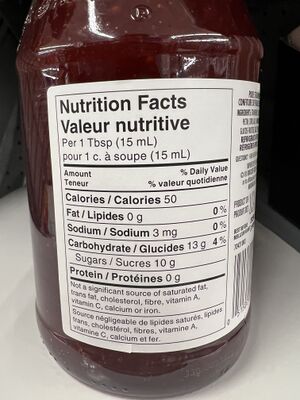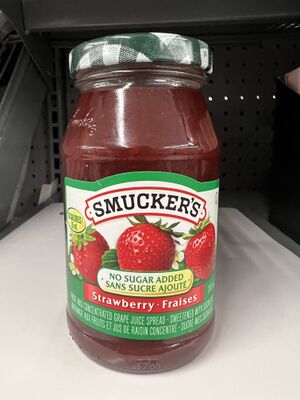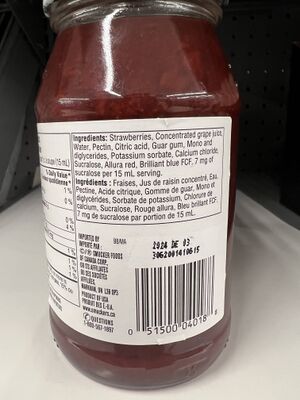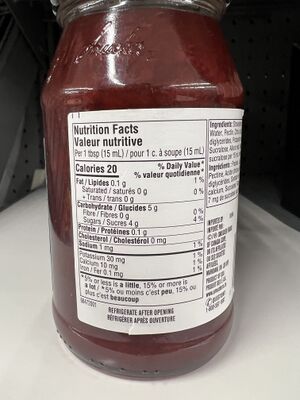Course:FNH200/Assignments/2023/Smucker's Strawberry Jam - Original vs No Sugar Added

Introduction
Strawberry jam is one of the oldest varieties of jams. It dates back to the 16th century in France,[1] and has become a worldwide breakfast, lunch, dinner and dessert staple in the diets of millions of consumers of all age groups. This is apparent as strawberry jam has reached a market size of 4,615.09 Million USD in 2023.[2]

As jams and spreads are continuing to experience increased demand, this number is estimated to almost double by 2027.[3] Nonetheless, there have been market shifts. Strawberry jam generally contains large amounts of sugar and with growing health concerns, people are searching for alternatives.

Smucker’s original strawberry jam contains 10 g of sugar per 15 mg, which is likely why the no sugar added alternative is now available. Due to Canadian food and drug regulations, Smucker’s is not permitted to name this no sugar added product “jam”, as a permitted sweetener (sucralose) was added, and the original item contains added sugars. Further, the fruit juice concentrate must be identified in the common name of the product. So, the no sugar added variety is named strawberry fruit and concentrated grape juice spread.[4]
The following information will explore this product, as well as the original product in detail. Either way, the sweetness of jams and spreads (whether via sweeteners or sweetening agents) allows them to pair wonderfully with either savoury foods, or desserts, making this an ideal addition to many meals and snacks.

Ingredients
1. Ingredient Lists

Smucker's Pure Strawberry Jam
Strawberries, Glucose-fructose, Sugar, Pectin, Citric Acid
Smucker’s No Sugar Added Strawberry Fruit and Concentrated Grape Juice Spread
Strawberries, Concentrated Grape Juice, Water, Pectin, Citric acid, Guar gum, Mono and diglycerides, Potassium sorbate, Calcium chloride, Sucralose, Allura red, Brilliant blue FCF. 7 mg of sucralose per 15 mL serving.

2. Substitutes & Additives used
| Smucker's Pure Strawberry Jam | Smucker’s No Sugar Added Strawberry Fruit and Concentrated Grape Juice Spread | |
|---|---|---|
| Sugar Substitutes | None | Sucralose |
| Fat Substitutes | None | None |
| Additives | Pectin, Citric acid | Pectin, Citric acid, Guar gum, Mono and diglycerides, Potassium sorbate, Calcium chloride, Allura red, Brilliant blue FCF |
3. Role of Substitutes & Additives
3.1 Smucker's Pure Strawberry Jam
Sugar substitutes: None
Fat substitutes: None
Additives:
1. Citric acid is a natural organic acid found in various foods such as tomatoes, strawberries, and citrus fruits. It plays a vital role in facilitating the gelling and thickening process in jam by enabling a favourable chemical reaction between pectin and sugar.[5] It also acts as a natural flavour enhancer in jams, regulating acidity and aiding in colour preservation. By creating an acidic environment, it inhibits the growth of bacteria and other microorganisms, thereby extending the shelf life of the product.[6] Citric acid is considered an additive in Canada when it is used as a pH adjusting agent.[7]
2. Pectin is a polysaccharide, often derived from the waste of processing apple products. In the presence of sufficient sugar and acid, it is used as a gelling, thickening and stabilizing agent in jam.[8] Pectin also helps to speed up the cooking process,[9] increase the shelf life, enhance the mouth feel and color of the jam.[10]
3.2 Smucker's No Sugar Added Strawberry Fruit and Concentrated Grape Juice Spread
Sugar substitutes:
1. Sucralose is a heat stable chlorinated molecule that is 600 times sweeter than sucrose. Because of this, it acts as an effective sweetener and flavour enhancer. It retains its sweetness over a variety of temperatures and storage conditions thereby performing the role of a stabilizer when added to jam.[11][12] It cannot be metabolised by the human body, thus, it is a calorie free substitute to sugar.[13] Furthermore, it does not fuel the growth of oral bacteria, deterring tooth decay.[14] One of its drawbacks is that it cannot be used as a preservative.[15]
Fat substitutes: None
Additives:
1. Pectin See pectin in Smucker's Pure Strawberry Jam section.
2. Citric acid See citric acid in Smucker's Pure Strawberry Jam section.
3. Guar gum is a polysaccharide and has excellent water absorbing qualities. This allows it to contribute towards the thickening and gelation process in jam, giving it a desired spreadable consistency.[16][17] It also plays the role of an emulsion stabilizer, preventing the separation of oil and water-based ingredients, adding texture to the product which in turn changes the sensory properties.[18]
4. Mono and diglycerides are derived from fatty acids, which serves as an emulsifier in jam to aid in the blending of water and oil and prevent their separation.[19] Additionally, they improve the texture,[20] provide the product stability,[21] control crystallization[22] and extend its shelf life.[23][24]
5. Potassium sorbate is an odourless and tasteless salt of sorbic acid which is widely used as a preservative in the food industry. It prolongs the shelf life by stopping the growth of bacteria, mold, yeast and fungi.[25] It is water soluble and does not change the quality of the product. It is generally regarded as safe, and passes through the human body harmlessly, without accumulating, (like water and carbon dioxide).[26]
6. Calcium chloride is a food additive used to maintain the texture of the jam. Its hygroscopic nature allows it to absorb moisture and provide firmness to the product.[27] It facilitates the gelling process through its presence, as pectin requires calcium to initiate the gelling process.[28]
7. Allura red and Brilliant blue FCF are artificial food dyes with excellent water solubility, commonly used to add color to baked goods, beverages, candies, jellies, sausages, and various other food items.[29] While these dyes are not entirely poisonous, their consumption can potentially give rise to health issues in humans.[30]
4. Compare and Contrast
Similarities
Both products contain strawberries and pectin.
Differences
Smucker's No Sugar Added Strawberry Fruit and Concentrated Grape Juice Spread contains sucralose to compensate for the sweetness provided by sugar and glucose-fructose in the formula for Smucker's Pure Strawberry Jam. In addition, guar gum is added to help thicken and stabilize the no sugar added spread. Potassium sorbate and calcium chloride work as preservatives in the absence of high sugar content. Allura red and brilliant blue FCF provide a more vibrant hue comparable to the original jam formula in the no sugar added spread.
Labels
| Core Labelling Requirements | |
|---|---|
| Bilingualism | Both products provide an English and French label despite being produced in the USA because it is imported to Canada.[31] |
| Common Name | Commonly known as strawberry jam and strawberry fruit and concentrated grape juice spread |
| Country of Origin | The jam and no added sugar spread are products of the USA. Country of origin labelling is required for processed fruit and vegetable products.[32] |
| Date Markings & Storage Instructions | A best-before date is located below the ingredients list on the label at the back of the no added sugar spread. On the jam, the best-before date is located below the country of origin.
|
| Name & Principle Place of Business | The principle place of business of The J.M. Smucker Company is Ohio, United States.[33] |
| Irradiation | Products are not irradiated. |
| Legibility & Location | The information on the label can be easily read and the product is readily available in Canada. |
| List of Ingredients and Allergens | List of ingredients can be seen in image 2 & 5
|
| Net Quantity | The volume of the jam is 500 mL (also available in 250 mL and 1L sizes). The volume of the no added sugar spread is 310 mL.
Volumes are listed on the front label of both the jam and the spread. |
| Nutrition Facts | The table contains the required information such as: calories, fat (saturated and trans), carbohydrate (fibre, sugars), protein, sodium, potassium, calcium, iron, and can be seen in images 3 & 6. |
| Sweeteners | Identified in the list of ingredients, and can be seen in image 2 & 5 |
| Food Additives | Identified in the list of ingredients, and can be seen in image 2 & 5 |
| Standards of Identity | The strawberry jam must comply with section B.11.201 of the FDR.[35][36] |
| Claims and Statements | |
| Composition & Quality | The strawberry fruit spread is labelled “no sugar added.”[37]
The strawberry jam is labelled “no artificial colours,” “no artificial flavours,” and “no preservatives.”[38] The term “pure” is used as a modifier of the common name “strawberry jam.”[39] |
| Method of Production | Both the jam and no added sugar spread are certified kosher by the Orthodox Union (OU) Certification Agency.[40][41] |
| Nutrient Content | On the no sugar added spread, the front label indicates that each 15 mL (1 tsp) serving contains 20 calories.[42][43] |
All labeling complies with with federal regulations outlined by The Food and Drugs Act of Canada.
References
- ↑ "Strawberry jam: an untouchable must-have or a source of inspiration?". Maison Andrésy. 14 April 2022. Retrieved 20 July 2023.
- ↑ "Jam, Jelly, & Preserves Market Size & Share Analysis - Industry Research Report - Growth Trends". Mordor Intelligence. Retrieved 20 July 2023.
- ↑ "Strawberry Jam Market Report, 2022-2027". IndustryARC.
- ↑ "Criteria for the Nutrient Content Claim No Added Sugars". Government of Canada. 3 August 2022. Retrieved 20 July 2023.
- ↑ "Food Additives. Why is Pectin in Jam? Citric acid? Why are some additives not listed?". adventures in jam. 6 September 2010. Retrieved 20 July 2023.
- ↑ Lehman, Shereen (01 July 2021). "Is Citric Acid Safe?". Verywell Fit. Retrieved 20 July 2023. Check date values in:
|date=(help) - ↑ "Food Standards, Regulations and Guides - Food Additives". FNH 200 - UBC Wiki. 24 June 2020. Retrieved 23 July 2023.
- ↑ "CFR - Code of Federal Regulations Title 21". US Food and Drug Administration. 7 November 1983. Retrieved 20 July 2023.
- ↑ Vanaee, Maryam (22 May 2022). "Pectin in Jam". Cademix Institute of Technology. Retrieved 20 July 2023.
- ↑ Han, James (13 January 2021). "What is Pectin (E440)? Sources, Types, Uses, and Benefits". FOODADDITIVES. Retrieved 20 July 2023.
- ↑ "Everything You Need to Know About Sucralose". Food Insight. 28 April 2021. Retrieved 20 July 2023.
- ↑ "Canning with Less Sugar". PennState Extension. 27 April 2023. Retrieved 20 July 2023.
- ↑ "Sucralose: Safety and Evidence". News-Medical.Net. 26 February 2019. Retrieved 20 July 2023.
- ↑ "Are Artificial Sweeteners Bad for You and Your Teeth?". Colgate. Retrieved 20 July 2023.
- ↑ "Frequently Asked General Preservation Questions". National Center for Home Food Preservation. Retrieved 20 July 2023.
- ↑ "Applications of Guar Gum Powder for Vegans". Altrafine Gums. 14 April 2021. Retrieved 20 July 2023.
- ↑ "How to Use Guar Gum in Your Recipes?". Cape Crystal Brands. 2 September 2022. Retrieved 20 July 2023.
|first=missing|last=(help) - ↑ "Guar Gum Powder: Uses & Benefits". Bob's Red Mill. 3 May 2020. Retrieved 20 July 2023.
- ↑ Vandergriendt, Carly (11 October 2017). "Monoglycerides: What Are They and Are They Safe?". Healthline. Retrieved 20 July 2023.
- ↑ Huizen, Jennifer (25 May 2018). "Monoglycerides: What are they, risks, and who should avoid them". Medical News Today. Retrieved 20 July 2023.
- ↑ Huizen, Jennifer (25 May 2018). "What are monoglycerides and are they safe?". Medical News Today. Retrieved 20 July 2023.
- ↑ "Sources of Food Ingredients: Mono- and Diglycerides". Food Ingredient Facts. 12 February 2021. Retrieved 21 July 2023.
- ↑ Vandergriendt, Carly (11 October 2017). "What Are Monoglycerides and Are They Safe to Consume?". Healthline. Retrieved 20 July 2023.
- ↑ "Monoglycerides: What are they, risks, and who should avoid them". Medical News Today. 25 May 2018. Retrieved 20 July 2023.
- ↑ "Potassium Sorbate". National Center for Biotechnology Information. PubChem Compound Database. Retrieved 20 July 2023.
- ↑ Hecht, Marjorie (30 March 2017). "Everything You Should Know About Potassium Sorbate". Healthline. Retrieved 20 July 2023.
- ↑ "Effect of citric acid, calcium lactate and low temperature prefreezing treatment on the quality of frozen strawberry". Annals of Agricultural Sciences. 26 July 2014. Retrieved 20 July 2023.
- ↑ "Pectin: not just for jelly". Popular Science. 8 July 2008. Retrieved 20 July 2023.
- ↑ "Simultaneous Extraction and Determination of Allura Red (E129) and Brilliant Blue FCF (E133) in Foodstuffs by Column Solid-Phase Spectrophotometry". Journal of AOAC International. 12 June 2018. Retrieved 20 July 2023.
- ↑ "Common food dye can trigger inflammatory bowel diseases, say McMaster researchers". McMaster University. 20 December 2022. Retrieved 20 July 2023.
- ↑ "Bilingual food labelling". Government of Canada. 20 July 2023. Retrieved 20 July 2023.
- ↑ "Labelling requirements for processed fruit or vegetable products". Government of Canada. 6 July 2022. Retrieved 20 July 2023.
- ↑ "From Our Family to Yours". The J. M. Smucker Company. Retrieved 20 July 2023.
- ↑ "Allergens and gluten sources labelling". Government of Canada. 15 June 2020. Retrieved 20 July 2023.
- ↑ "Canadian Standards of Identity: Volume 4 – Processed Fruit or Vegetable Products". Government of Canada. 28 April 2021. Retrieved 20 July 2023.
- ↑ "Food and Drug Regulations: PART B Foods (continued): DIVISION 11 Fruits, Vegetables, Their Products and Substitutes (continued)". Government of Canada. 7 July 2023. Retrieved 20 July 2023. line feed character in
|title=at position 34 (help) - ↑ "Criteria for the Nutrient Content Claim No Added Sugars". Government of Canada. 3 August 2022. Retrieved 20 July 2023.
- ↑ "Food composition and quality claims". Government of Canada. 6 July 2022. Retrieved 20 July 2023.
- ↑ "Food composition and quality claims". Government of Canada. 6 July 2022. Retrieved 20 July 2023.
- ↑ "Method of production claims on food labels". Government of Canada. 6 July 2022. Retrieved 20 July 2023.
- ↑ "OU Kosher Symbols Explained". OU Kosher Certification. 22 February 2022. Retrieved 20 July 2023.
- ↑ "Declaring nutrients outside the Nutrition Facts table". Government of Canada. June 22 2023. Retrieved 20 July 2023. Check date values in:
|date=(help) - ↑ "Serving sizes and reference amounts". Government of Canada. June 22 2023. Retrieved 20 July 2023. Check date values in:
|date=(help)
| This Food Science resource was created by Course:FNH200. |
